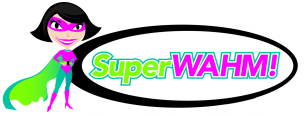
How to Write For the Web
Today’s post, and the following two this week, are brought to you by Marc Pieniazek of Welsh Scribe.
Marc has the honour of being the very first Guest Poster on this blog! He writes great copy, has a wicked sense of humour and is a lovely guy to know. I hope you all enjoy his posts here as much as I do.
This first post in a 3-part series explores the structure of a blog post, in particular what you need to do in order to draw the reader in and get your message across.
Lets face it. Writing for the web is totally different from any other form of writing you have to do. Take a novel for example. Unless you’re a 3 year old, you don’t care that your book doesn’t have any pictures in it but we all know how important it is to have an image in our blog posts.
The most critical factor however is attention span. Not only do you have to grab a reader’s attention but you have to keep it. A difficult feat in this day and age.
Fortunately there are a few things you can do to increase your reader retention.
Start At The Top
The title is the first thing any potential reader will see and is therefore the most important element in any online writing. Don’t underestimate its power.
You can have the most important message mankind will ever hear, the best product or service guaranteed to solve every one’s problems but if your title fails to attract attention, that message won’t be spread and no-one will buy that super product or service of yours.
Steal From Others
T.S Eliot once said, “Immature poets imitate; mature poets steal.”
Marketers call it a swipe file.
If you want to know what titles get the most attention then copy what works. Not word for word, obviously, The title has to remain true to your post. “Top 10 Fashion Tips From The Celebs” is no good if you blog about dog grooming.
Brian Clark has an entire series on how to write magnetic headlines. Well worth a read but if you’re looking to get off the ground quickly here’s a list of time-tested titles that draw in the most readers.
• The “How To…”: It’s no coincidence that this post begins with the words “How To”. How to articles are the most sought after content online.
• The “Top X…”: Another extremely popular type of article or blog post is the list post and an easy way of creating a list is by compiling a Top 10 or 50 or 100.
• The “X reasons/secrets/ways Why…”: Expanding on the above point about list posts are titles containing a number of reasons or ways why something will work. The best example is Brian’s article 7 Reasons Why List Posts Always Work. On my own blog, the top 3 popular posts are of this format.
• The “[celebrity] Guide To…”: Everyone wants to be successful at something and there’s no better example of success than a celebrity. This is why my post “What the Phantom Of the Opera Can Teach You About Writing” is still getting traffic or why “The Winnie the Pooh Guide To Blogging” received 132 comments.
So there you have it. Next time you write a blog post try fitting the title into one of the above categories. Spend a considerable amount of time on it, your post deserves it.
In the next post in this 3 part series I’ll take a closer look at the body of the blog post and what you need to do in order to get your message across, even to those that just skim through.
Marc is a freelance writer and work from home dad – and SEO specialist who helps freelancers build a profitable business.

Melinda is the founder of SuperWAHM.com and started this site to share her best work from home ideas to help other Work At Home Mums become more financially independent and able to spend time with their families.



Completely agree about the not writing for SEO. Couldn’t do it on my blog if I wanted to. Thesis is set up so you can do it after a post, in the meta data and keywords, the photo titles etc. I’m no expert, but that makes more sense to me. Look forward to your take on SEO, Marc.
janice’s last blog post..Writing to Connect: Does Your Writing Stink?
In my opinion it’s one of the biggest misconceptions about SEO, that we have to employ a totally different style of writing. It’s just not true.
Think of it this way. Why would Google spend billions of dollars researching how humans search and then reward the sites that write content for machines?
Yes keyword research and all that is important but all else being equal it comes down to links. It was the premise upon which Google was built; a link to a webpage is like a vote, someone has said “I like this webpage”.
What do you think will get the most votes, an article written for humans or an article written for Google?
@ Barbara, want to post a link to that post here? Sounds interesting!
@ Writer Dad, I love my swipe file too, it’s one of the best ‘tools’ I have.
@ Janice, thanks, I like my first guest poster too! Re the SEO, I’m no expert in SEO but I’ve been doing a lot of reading and researching – it’s a topic that comes up with my clients all the time. I don’t think you can write deliberately for SEO, not and have good quality posts that are well written, full of quality information and easy to read. I read somewhere that the best way to write for SEO was to forget about it and write for your niche – and that would naturally and organically incorporate all your keywords and phrases that would be searched on and would thus bring the SEO in.
This isn’t quite focused on SEO Janice, it’s more about getting your article noticed (and clicked on) in a sea of other articles. Sure the “how to” is probably the most searched for so you are right there is an element of SEO but that’s for another post for another day 🙂
@Barbara great post title! It’s that kind of intrigue that gets the potential reader to click
@Sean Like me then, my swipe file is like my treasure chest 🙂
Marc – WelshScribe’s last blog post..Spreading Myself Too Thin
Nice choice of guest post-er, Mel. You won’t get any disagreements from me about what a sound guy Marc is.I’ve benefitted many times from his advice in comments boxes and by email as well as in his blogs.
You’re right, Marc. For those folk who are focused on SEO, this is really sound advice. I seldom do any of it on my blog – which is deliberate – but you have to know these basics before you can rebel. I use the How to etc titles when I do guest posts; I owe it to my hosts. I also agree about how important images are, but because my header is so wild, I had to accept that I’d be embedding within the post rather than heading it up. But my stats show that I get almost no visitors from SEO, so, defeatist as it may sound, I’ve decided to just use any titles I fancy and have fun.
I look forward to part two!
janice’s last blog post..Writing to Connect: Does Your Writing Stink?
Hey Marc! Fun to see you here, what a surprise!
I would be nowhere without my trusty swipe file.
Writer Dad’s last blog post..7 Easy (And Fun!) Exercises to Boost Your Creativity
One of my most popular articles at another blog of mine was
What Getting Kicked Thru the Air Taught Me About Blogging
so yes indeed, headlines work. 🙂
Good post!
Barbara Ling’s last blog post..#futuresummit